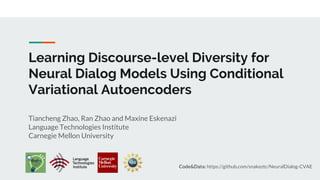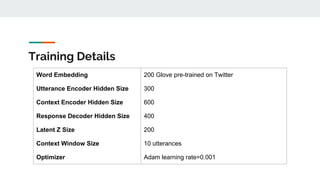Tiancheng Zhao - 2017 - Learning Discourse-level Diversity for Neural Dialog Models Using Conditional Variational Autoencoders
- 1. Learning Discourse-level Diversity for Neural Dialog Models Using Conditional Variational Autoencoders Tiancheng Zhao, Ran Zhao and Maxine Eskenazi Language Technologies Institute Carnegie Mellon University Code&Data: https://github.com/snakeztc/NeuralDialog-CVAE
- 2. Introduction ● End-to-end dialog models based on encoder-decoder models have shown great promises for modeling open-domain conversations, due to its flexibility and scalability. System Response Encoder Decoder Dialog History/Context
- 3. Introduction However, dull response problem! [Li et al 2015, Serban et al. 2016]. Current solutions include: ● Add more info to the dialog context [Xing et al 2016, Li et al 2016] ● Improve decoding algorithm, e.g. beam search [Wiseman and Rush 2016] YesI don’t knowsure Encoder Decoder User: I am feeling quite happy today. … (previous utterances)
- 4. Our Key Insights ● Response generation in conversation is a ONE-TO-MANY mapping problem at the discourse level. ● A similar dialog context can have many different yet valid responses. ● Learn a probabilistic distribution over the valid responses instead of only keep the most likely one.
- 5. Our Key Insights ● Response generation in conversation is a ONE-TO-MANY mapping problem at the discourse level. ○ A similar dialog context can have many different yet valid responses. ● Learn a probabilistic distribution over the valid responses instead of only keep the most likely one.
- 6. Our Contributions 1. Present an E2E dialog model adapted from Conditional Variational Autoencoder (CVAE). 2. Enable integration of expert knowledge via knowledge-guided CVAE. 3. Improve the training method of optimizing CVAE/VAE for text generation.
- 7. Conditional Variational Auto Encoder (CVAE) ● C is dialog context ○ B: Do you like cats? A: Yes I do ● Z is the latent variable (gaussian) ● X is the next response ○ B: So do I.
- 8. Conditional Variational Auto Encoder (CVAE) ● C is dialog context ○ B: Do you like cats? A: Yes I do ● Z is the latent variable (gaussian) ● X is the next response ○ B: So do I. ● Trained by Stochastic Gradient Variational Bayes (SGVB) [Kingma and Welling 2013]
- 9. Knowledge-Guided CVAE (kgCVAE) ● Y is linguistic features extracted from responses ○ Dialog act: statement -> “So do I”. ● Use Y to guide the learning of latent Z
- 10. Training of (kg)CVAE Reconstruction loss KL-divergence loss
- 12. Optimization Challenge Training CVAE with RNN decoder is hard due to the vanishing latent variable problem [Bowman et al., 2015] ● RNN decoder can cheat by using LM information and ignore Z! Bowman et al. [2015] described two methods to alleviate the problem : 1. KL annealing (KLA): gradually increase the weight of KL term from 0 to 1 (need early stop). 2. Word drop decoding: setting a proportion of target words to 0 (need careful parameter picking).
- 13. BOW Loss ● Predict the bag-of-words in the responses X at once (word counts in the response) ● Break the dependency between words and eliminate the chance of cheating based on LM. z c RNN Lossx
- 14. BOW Loss ● Predict the bag-of-words in the responses X at once (word counts in the response) ● Break the dependency between words and eliminate the chance of cheating based on LM. z c RNN Lossx xwo FF Bag-of-word Loss
- 15. Dataset Data Name Switchboard Release 2 Number of dialogs 2,400 (2316/60/62 - train/valid/test) Number of context-response pairs 207,833/5,225/5,481 Vocabulary Size Top 10K Dialog Act Labels 42 types, tagged by SVM and human Number of Topics 70 tagged by humans
- 16. Quantitative Metrics Ref resp1 Ref resp Mc Context Hyp resp 1 Hyp resp N ModelHuman ... ...
- 17. Quantitative Metrics d(r, h) is a distance function [0, 1] to measure the similarity between a reference and a hypothesis. Appropriateness Diversity Ref resp1 Ref resp Mc Context Hyp resp 1 Hyp resp N ModelHuman ... ...
- 18. Distance Functions used for Evaluation 1. Smoothed Sentence-level BLEU (1/2/3/4): lexical similarity 2. Cosine distance of Bag-of-word Embeddings: distributed semantic similarity. (pre-trained Glove embedding on twitter) a. Average of embeddings (A-bow) b. Extrema of embeddings (E-bow) 3. Dialog Act Match: illocutionary force-level similarity a. (Use pre-trained dialog act tagger for tagging)
- 19. Models (trained with BOW loss) Encoder Sampling Decoder Encoder Greedy Decoder Encoder Greedy Decoder z z y sampling sampling Baseline CVAE kgCVAE
- 20. Quantitative Analysis Results Metrics Perplexi ty (KL) BLEU-1 (p/r) BLEU-2 (p/r) BLEU-3 (p/r) BLEU-4 (p/r) A-bow (p/r) E-bow (p/r) DA (p/r) Baseline (sample) 35.4 (n/a) 0.405/ 0.336 0.3/ 0.281 0.272/ 0.254 0.226/ 0.215 0.387/ 0.337 0.701/ 0.684 0.736/ 0.514 CVAE (greedy) 20.2 (11.36) 0.372/ 0.381 0.295/ 0.322 0.265/ 0.292 0.223/ 0.248 0.389/ 0.361 0.705/ 0.709 0.704/ 0.604 kgCVAE (greedy) 16.02 (13.08) 0.412/ 0.411 0.350/ 0.356 0.310/ 0.318 0.262/ 0.272 0.373/ 0.336 0.711/ 0.712 0.721/ 0.598 Note: BLEU are normalized into [0, 1] to be valid precision and recall distance function
- 21. Qualitative Analysis Topic: Recycling Context: A: are they doing a lot of recycling out in Georgia? Target (statement): well at my workplace we have places for aluminium cans Baseline + Sampling kgCVAE + Greedy 1. well I’m a graduate student and have two kids. 1. (non-understand) pardon. 2. well I was in last year and so we’ve had lots of recycling. 2. (statement) oh you’re not going to have a curbside pick up here. 3. I’m not sure. 3. (statement) okay I am sure about a recycling center. 4. well I don’t know I just moved here in new york. 4. (yes-answer) yeah so.
- 22. Latent Space Visualization ● Visualization of the posterior Z on the test dataset in 2D space using t-SNE. ● Assign different colors to the top 8 frequent dialog acts. ● The size of circle represents the response length. ● Exhibit clear clusterings of responses w.r.t the dialog act
- 23. The Effect of BOW Loss Same setup on PennTree Bank for LM [Bowman 2015]. Compare 4 setups: 1. Standard VAE 2. KL Annealing (KLA) 3. BOW 4. BOW + KLA Goal: low reconstruction loss + small but non-trivial KL cost Model Perplexity KL Cost Standard 122.0 0.05 KLA 111.5 2.02 BOW 97.72 7.41 BOW+KLA 73.04 15.94
- 24. KL Cost during Training ● Standard model suffers from vanishing latent variable. ● KLA requires early stopping. ● BOW leads to stable convergence with/without KLA. ● The same trend is observed on CVAE.
- 25. Conclusion and Future Work ● Identify the ONE-TO-MANY nature of open-domain dialog modeling ● Propose two novel models based on latent variables models for generating diverse yet appropriate responses. ● Explore further in the direction of leveraging both past linguistic findings and deep models for controllability and explainability. ● Utilize crowdsourcing to yield more robust evaluation. Code available here! https://github.com/snakeztc/NeuralDialog-CVAE
- 27. References 1. Jiwei Li, Michel Galley, Chris Brockett, Jianfeng Gao, and Bill Dolan. 2016a. A persona-based neural conversation model. arXiv preprint arXiv:1603.06155 2. Jiwei Li, Michel Galley, Chris Brockett, Jianfeng Gao, and Bill Dolan. 2015. A diversity-promoting objective function for neural conversation models. arXiv preprint arXiv:1510.03055 . 3. Samuel R Bowman, Luke Vilnis, Oriol Vinyals, An- drew M Dai, Rafal Jozefowicz, and Samy Bengio. 2015. Generating sentences from a continuous space. arXiv preprint arXiv:1511.06349 . 4. Diederik P Kingma and Max Welling. 2013. Auto- encoding variational bayes. arXiv preprint arXiv:1312.6114 . 5. Jiwei Li, Michel Galley, Chris Brockett, Jianfeng Gao, and Bill Dolan. 2016a. A persona-based neural conversation model. arXiv preprint arXiv:1603.06155
- 28. Training Details Word Embedding 200 Glove pre-trained on Twitter Utterance Encoder Hidden Size 300 Context Encoder Hidden Size 600 Response Decoder Hidden Size 400 Latent Z Size 200 Context Window Size 10 utterances Optimizer Adam learning rate=0.001
- 29. Testset Creation ● Use 10-nearest neighbour to collect similar context in the training data ● Label a subset of the appropriateness of the 10 responses by 2 human annotators ● bootstrap via SVM on the whole test set (5481 context/response) ● Resulting 6.79 Avg references responses/context ● Distinct reference dialog acts 4.2



![Introduction
However, dull response problem! [Li et al 2015, Serban et al. 2016]. Current solutions
include:
● Add more info to the dialog context [Xing et al 2016, Li et al 2016]
● Improve decoding algorithm, e.g. beam search [Wiseman and Rush 2016]
YesI don’t knowsure
Encoder Decoder
User: I am feeling quite happy today.
… (previous utterances)](https://image.slidesharecdn.com/p17-1061-170918185614/85/Tiancheng-Zhao-2017-Learning-Discourse-level-Diversity-for-Neural-Dialog-Models-Using-Conditional-Variational-Autoencoders-3-320.jpg)




![Conditional Variational Auto Encoder (CVAE)
● C is dialog context
○ B: Do you like cats? A: Yes I do
● Z is the latent variable (gaussian)
● X is the next response
○ B: So do I.
● Trained by Stochastic Gradient Variational
Bayes (SGVB) [Kingma and Welling 2013]](https://image.slidesharecdn.com/p17-1061-170918185614/85/Tiancheng-Zhao-2017-Learning-Discourse-level-Diversity-for-Neural-Dialog-Models-Using-Conditional-Variational-Autoencoders-8-320.jpg)



![Optimization Challenge
Training CVAE with RNN decoder is hard due to the vanishing latent variable problem
[Bowman et al., 2015]
● RNN decoder can cheat by using LM information and ignore Z!
Bowman et al. [2015] described two methods to alleviate the problem :
1. KL annealing (KLA): gradually increase the weight of KL term from 0 to 1 (need early stop).
2. Word drop decoding: setting a proportion of target words to 0 (need careful parameter
picking).](https://image.slidesharecdn.com/p17-1061-170918185614/85/Tiancheng-Zhao-2017-Learning-Discourse-level-Diversity-for-Neural-Dialog-Models-Using-Conditional-Variational-Autoencoders-12-320.jpg)




![Quantitative Metrics
d(r, h) is a distance function [0, 1] to measure the similarity between a reference and a hypothesis.
Appropriateness
Diversity
Ref resp1
Ref resp Mc
Context
Hyp resp 1
Hyp resp N
ModelHuman ... ...](https://image.slidesharecdn.com/p17-1061-170918185614/85/Tiancheng-Zhao-2017-Learning-Discourse-level-Diversity-for-Neural-Dialog-Models-Using-Conditional-Variational-Autoencoders-17-320.jpg)


![Quantitative Analysis Results
Metrics Perplexi
ty (KL)
BLEU-1
(p/r)
BLEU-2
(p/r)
BLEU-3
(p/r)
BLEU-4
(p/r)
A-bow
(p/r)
E-bow
(p/r)
DA
(p/r)
Baseline
(sample)
35.4
(n/a)
0.405/
0.336
0.3/
0.281
0.272/
0.254
0.226/
0.215
0.387/
0.337
0.701/
0.684
0.736/
0.514
CVAE
(greedy)
20.2
(11.36)
0.372/
0.381
0.295/
0.322
0.265/
0.292
0.223/
0.248
0.389/
0.361
0.705/
0.709
0.704/
0.604
kgCVAE
(greedy)
16.02
(13.08)
0.412/
0.411
0.350/
0.356
0.310/
0.318
0.262/
0.272
0.373/
0.336
0.711/
0.712
0.721/
0.598
Note: BLEU are normalized into [0, 1] to be valid precision and recall distance function](https://image.slidesharecdn.com/p17-1061-170918185614/85/Tiancheng-Zhao-2017-Learning-Discourse-level-Diversity-for-Neural-Dialog-Models-Using-Conditional-Variational-Autoencoders-20-320.jpg)


![The Effect of BOW Loss
Same setup on PennTree Bank for LM
[Bowman 2015]. Compare 4 setups:
1. Standard VAE
2. KL Annealing (KLA)
3. BOW
4. BOW + KLA
Goal: low reconstruction loss + small
but non-trivial KL cost
Model Perplexity KL Cost
Standard 122.0 0.05
KLA 111.5 2.02
BOW 97.72 7.41
BOW+KLA 73.04 15.94](https://image.slidesharecdn.com/p17-1061-170918185614/85/Tiancheng-Zhao-2017-Learning-Discourse-level-Diversity-for-Neural-Dialog-Models-Using-Conditional-Variational-Autoencoders-23-320.jpg)





